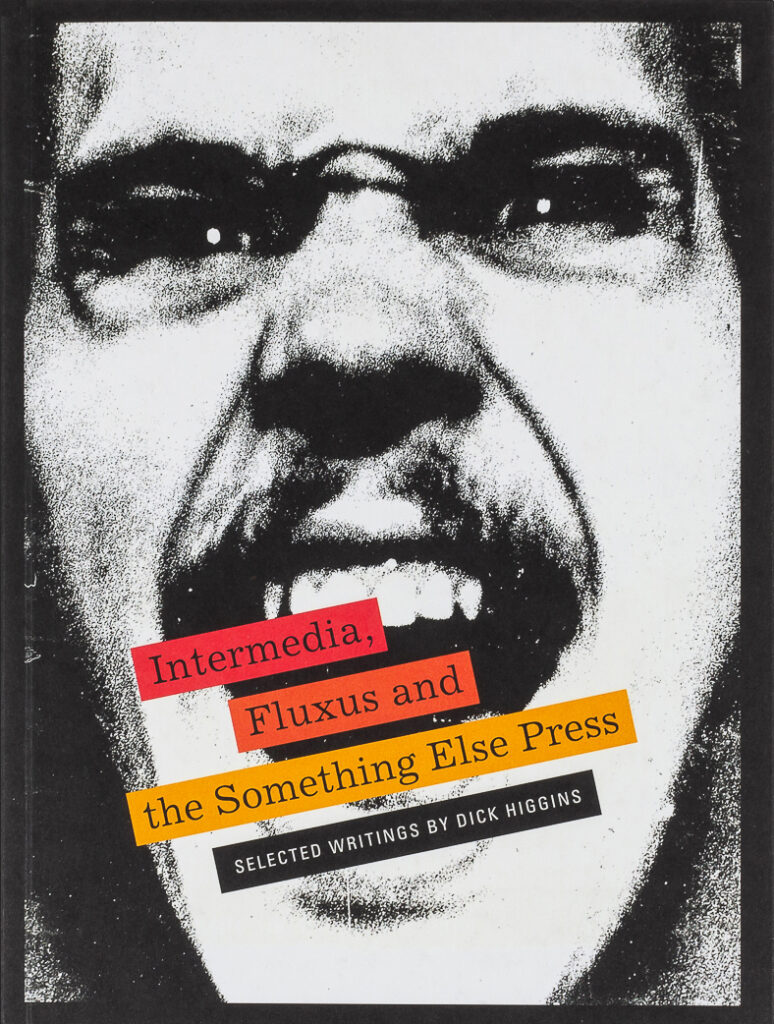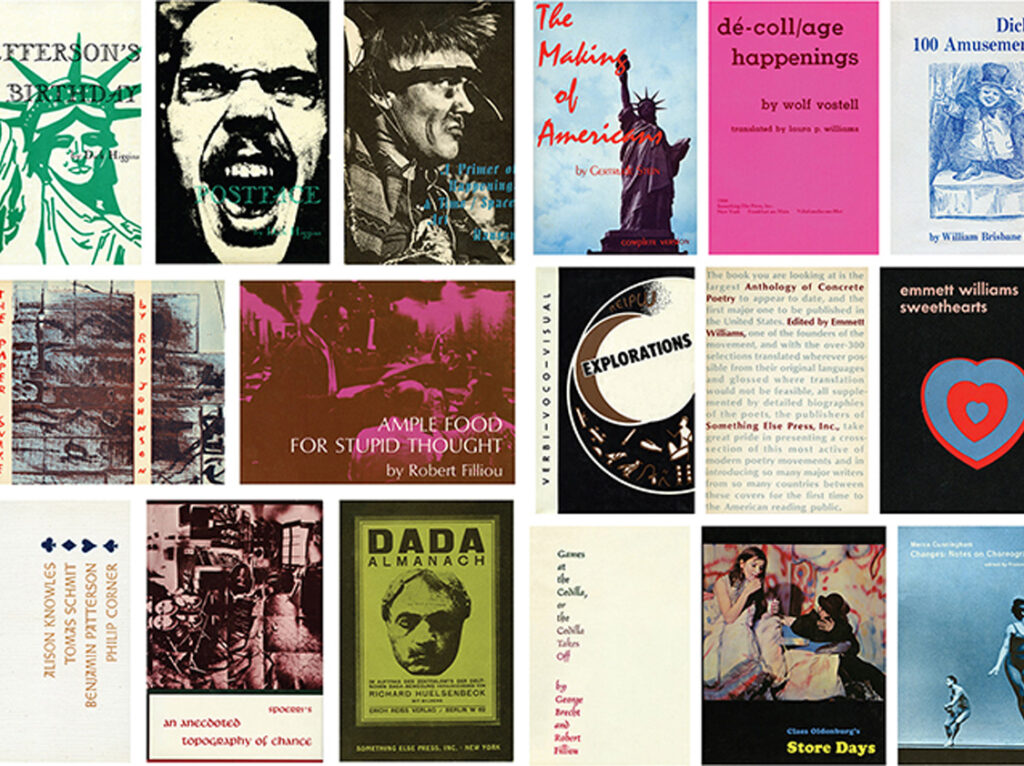“Higginsonian Pleasure All Around”Joshua Beckman
affinities, 01/02/19
These are remarks made by Joshua Beckman on December 4, 2018 at Poets House, New York City for the Passwords program honoring Dick Higgins. Reproduced with permission (and gratitude!).
I would like to read a handful of things I found in this book and read some of the poems and writings the book sent me to. My hope is just to share some of the exuberance I have found over the years in the things Dick Higgins put into the world. As a maker of books, seeing his productions, each full of that excitement of encounter, believing in the book as a possible place for encounter. As I was reading this book one of the things it did and I imagine one of things it really hopes to do, was send me off in every direction. Wandering around my own library and then getting caught inside each book I found. I spent a day with Abraham Lincoln Gillespie and another getting completely lost in 100 visual fascinations of pattern poetry. In one moment he can see in repeated phrases a formal patterning or suggest a poem in which phrases relate geometrically “shapes get(ting) their relevance from their relation to other shapes” and see in lines of a poem the same. Then in the middle of one I found top to bottom a string of words that moves off the edges of the page (suggesting to the side that it “be written upon the air and strung from the bottom of the sea to the top of the moon” And then I found this:
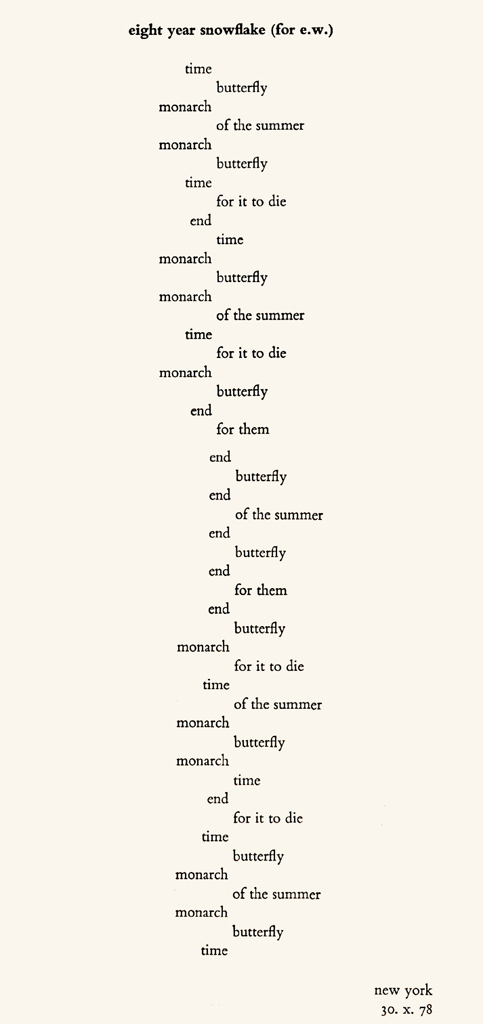
That was from some recent snowflakes (and other things) about which he writes:
Speculating on [Giordano] Bruno and poetry led me to start a new cycle of poems in what I call “snowflake form” because of their visual symmetry.
(the poems are like rings moving out from the center – the lines echo themselves so that the last is same as the first and the second to last the same as the second etc.)
Elements of these poems had been in my work for a long time, but the first full fledged and conscious use of the visual cancrizan was in my poem “The Snow Flakes of Giordano Bruno” which I printed first as a Christmas card in 1978”
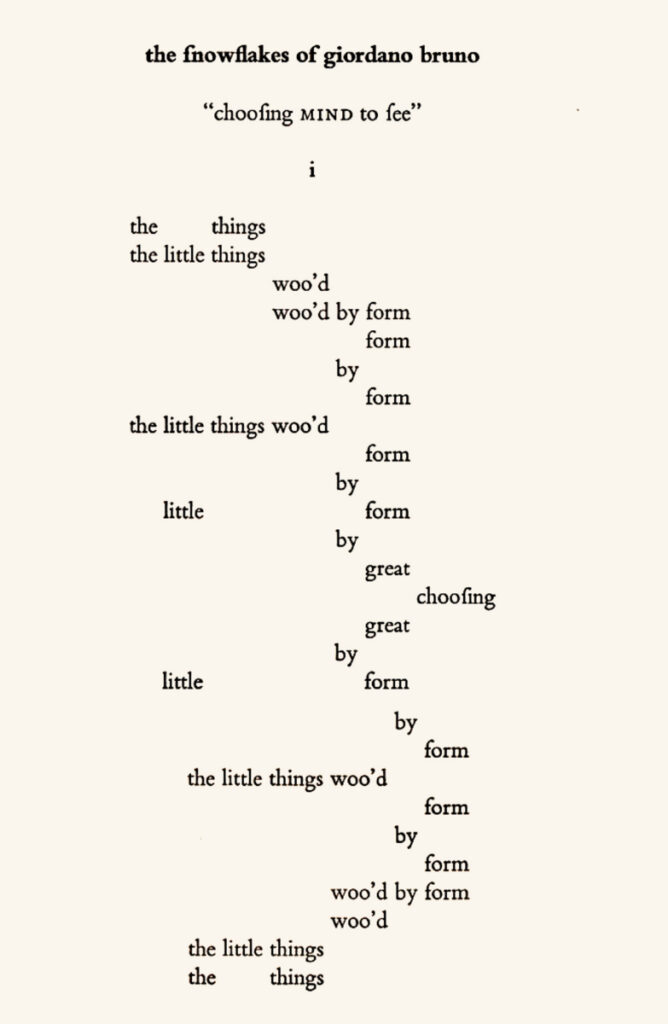
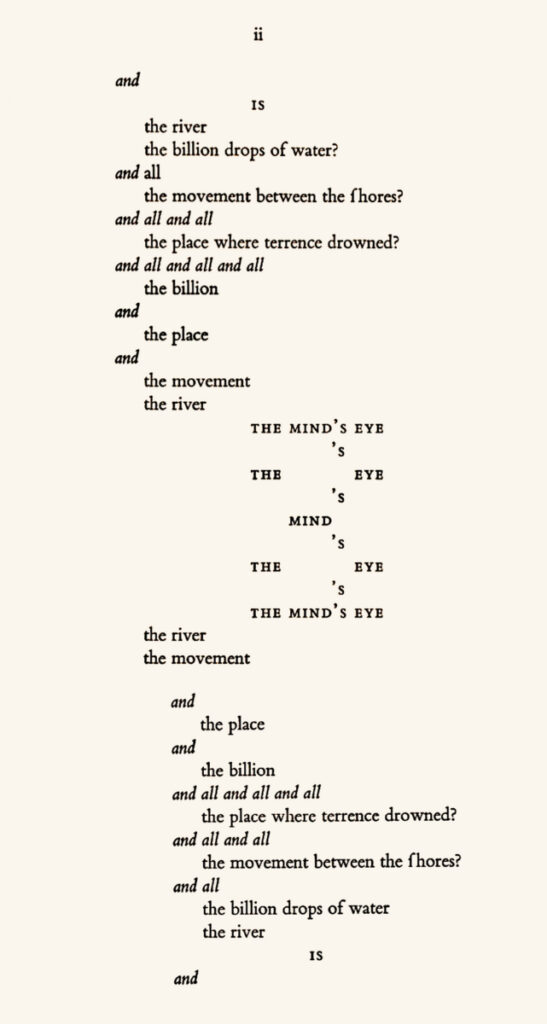
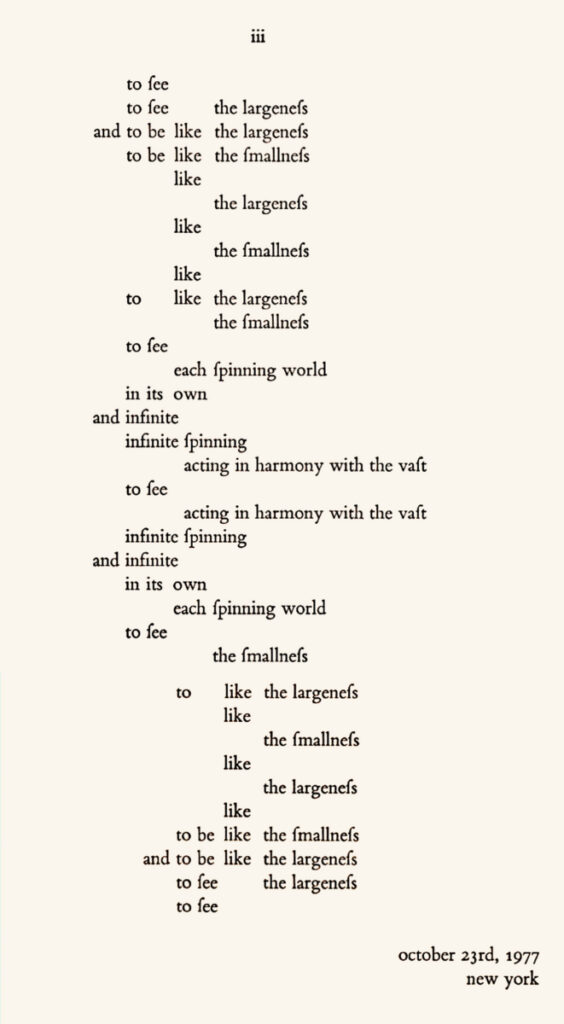
Hearing these snowflakes I felt simultaneously those individual experiences with the poems and an unfolding of the form presenting itself not just to be seen and experienced, but as an enthusiastic and generous handing over of the form to be tried. Going through the new book I constantly come across that exact generosity. That all his investigative excitement results in satisfactions rather than possessions, not in having but in sharing.
In the mid-nineties my friend James Walsh introduced me to Dick. I was briefly living in the Hudson Valley and we went over to visit him at the renovated church that was his home and studio. What I remember most, besides the basic pummeling of senses in the presence of so many made things, printed matter and private objects, was what seemed to be his main concern at that moment. He was in the process of gathering together a collection of all the books designed by a single designer. Merle Armitage. He was handing them to us and showing us different things about them and talking about the few he still had left to find.
As with so much of what of his I have found since, what he did in person was provide an encounter with all sides of the art experience at once, at once and in movement, buoyant and energetic. For me the practices of writing making having and considering books was constant and interrelated, but what he shared was a fluid disregard for the boundaries as boundaries, not just of the practices considered art but of all the interconnecting practices of production and encounter. He was making a font he was constructing a bibliography he was painting a painting for the cover of a book.
Thinking about him and his work, I see that openness and exuberance result in sweeping changes in the press and his own writings. And one of the many fascinating things I found in this new volume was his essay “The Strategy of Each of My Books,” laying out basically what you would imagine. For me what becomes so spectacular is not just the variety but, his attention to the energy of shifting and changing. About one of my personal favorites, The Epickall Quest of the Brothers Dichtung and Other Outrages, he writes this charming note:
The title story is the result of first writing a long essay on the narrative theory of two of the Jena group of German romantics, Friedrich and Augustus Wilhelm Schlegel while, simultaneously, reading John Bunyon’s Pilgrim’s Progress. I realized that there were probably only a dozen or so people in the world who would understand my essay, so I discarded it: but its traces remained in my mind. So I wrote instead a satirical novella about the American literary scene, interspersing many of the Schlegel Brothers ideas, and giving the whole the picaresque plot of two brother poets wandering toward Mount Parnassus. Also in the book is an account of European history seen in the microcosm of the croissant.
To give you a sense, some of the chapter titles include: The True History of the Croissant, The Croissant Rises Again, The Genetic Composition of the Croissant, and of course A Theoretical Digression Concerning Silliness
But if I step back and look at what he published just a year earlier
EVERYONE HAS SHER FAVORITE (HIS OR HERS)
it feels very much something else:
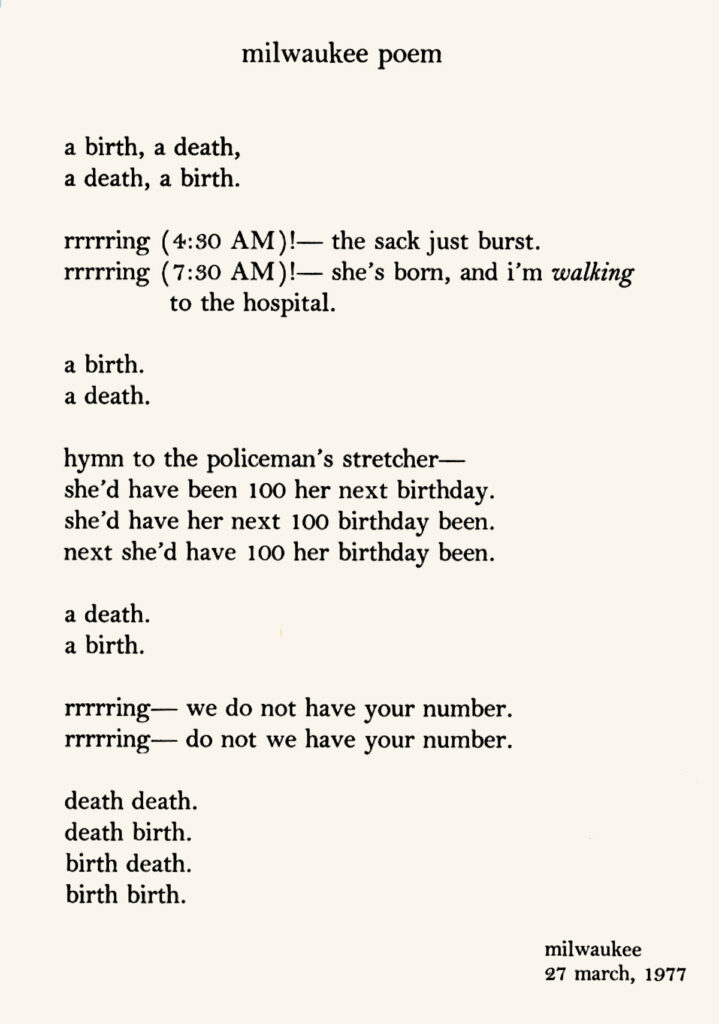
Or there on the next page, a much smaller one:
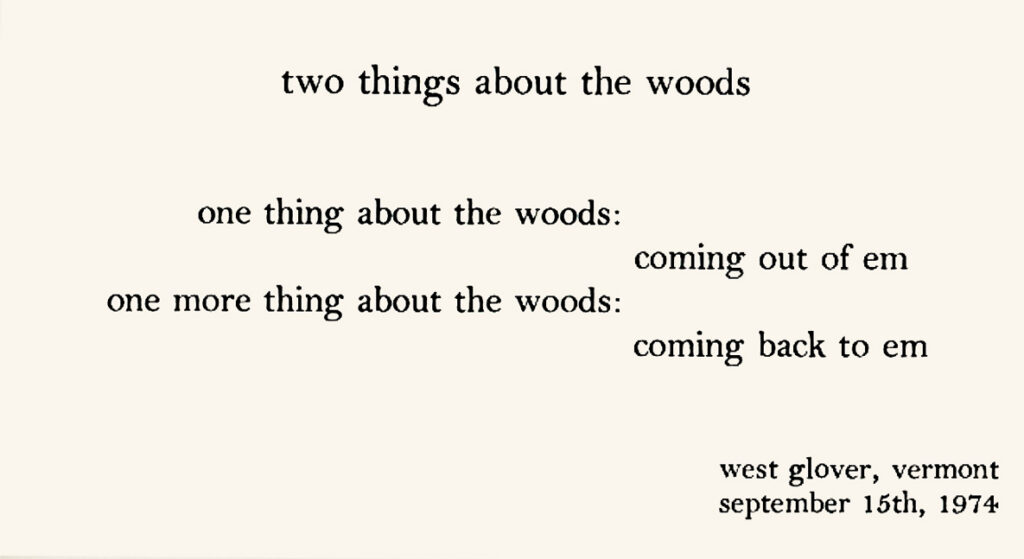
I now live a few miles away from where he did when I met him, about the same distance from the river and surrounded by the same trees and with the same creatures and light around. It was June and I would sit outside of my house as it grew dark and at first a few and then hundreds of fireflies would fill the woods and the yard and I would watch as if a sort of composition was being constructed and Lisa and Richard were over and I had this memory that there was a score for fireflies, that I had read it or seen pictures and I looked through everything and couldn’t find it so asked my friend James if he remembered it and he said it was a postcard that Dick had sent him. So, then James had to go rooting around through books and papers and boxes and stuff. It was titled firefly music
Firefly Music:
In the evening during firefly season a group of wind musicians go to a place where there are likely to be fireflies. They spread out but remain in hearing distance from each other.
Each faces in one direction and watches for the fireflies to flash. For each firefly flash the musician produces a sound which lasts as long as the flash. The more to the left the flash which is seen, the lower the register… etc.
and it finishes
The duration of the performance is free, as is the question of the presence of spectators.
17. June 1991
now December 4, 2018, audience here searching and finding
Higginsonian pleasure all around.
see also
✼ elsewhere:
“In my opinion, genre is a way of speaking about conventions of reading and looking, where you sit or stand and whether you’re allowed to talk to other people or move around while you’re communing with an object or text.” —Lucy Ives, from her interview with Karla Kelsey in Feminist Poetics of the Archive at Tupelo Quarterly
[...]